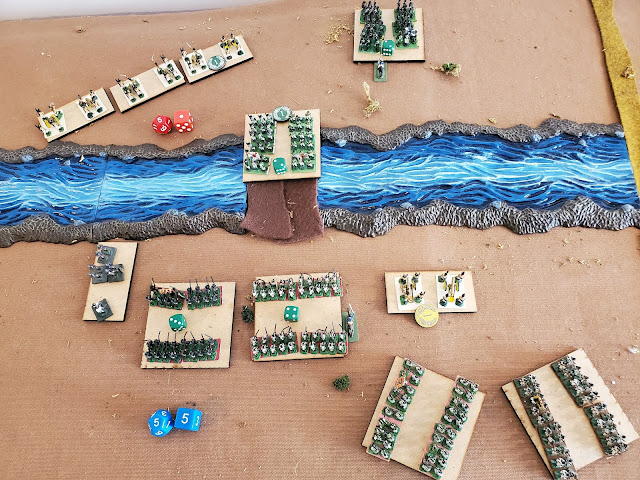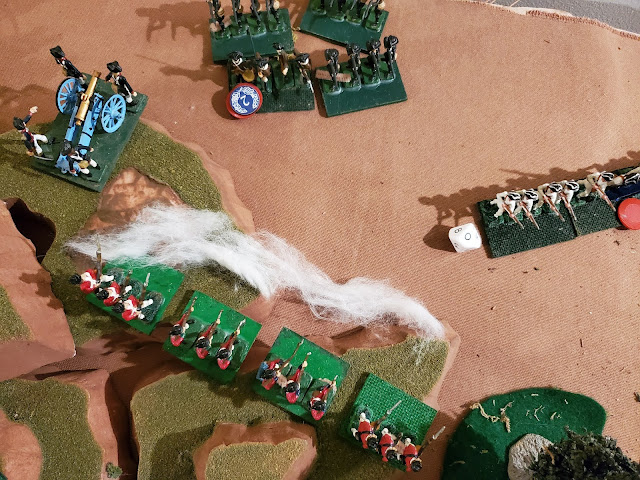After much eventfulness in the world - which swept me up into it - I was finally able to return to Eagles Cheaper than Brain Cells and see the last set of revisions with fresh eyes... in fact, I had sort of lost track of exactly what had happened, and had to refresh my memory as well as the eyes! Fortunately, I had scribbled plenty of notes from the last playtest sessions almost a year ago with an experienced game pal, Ken.
First thing was to try a new scenario, and #19 Blow from the Rear was just the ticket. Outflanking a river obstacle turns the scenario from an obvious defender's advantage to a desperate defense on Turn 6. There is always a bit of trouble with a flank attack if both sides [me, and well, me] know it is going to happen.
This scenario attempts to balance the tension with the setup. The attacker starts with 1/2 his force entering from board North to contest the two crossings, opposed by 2/3 of the defense. The other 1/3 of the defense is in reserve in the shaded area to bottom right. On Turn 6, the other half of the attacking force enters from the West, south of the woods. On Turn 7, the defender's reserve is free to react to this unpleasant development.
Couple interesting things to note about this scenario, is that using the random force generator can make for some challenging forces for either side. Certainly, both side's forces at the river will get the most use out of artillery - the attacker needs it to soften up the defense and force a crossing, the defender needs it to weaken the attacker's holding force enough that it can only cross with assistance from the flanking force. Cavalry for the flanking force and defender's reserve will be very handy.
The Victory Condition is pretty demanding on the Attacker - he must clear both crossings of any enemy units for 6" in every direction.
All in all an interesting tactical challenge for both sides.
Increasing both sides to ten units [rolling once each on the 6 Unit Force Table, and once on the 4 Unit Force Table, p. 64] resulted in the below forces:
Russians - 3 Artillery, 5 Infantry and 2 Cavalry
Austrians - 1 Artillery, 6 Infantry, 2 Cavalry, and 1 Skirmisher
This worked out nicely, with the Russians having the capability to push at the crossings thanks to a significant artillery advantage, and the Austrians having the only Skirmisher to operate effectively in the woods, a good defender's advantage.
To get the feel of the newly acquired N-Scale Scruby figs, I left them on the bases they came with and used 3" square sabots [1.5" x 3" for the Artillery] in the style of Volley & Bayonet. As both EC-BC shares the same ground scale as V&B, and Frank Chadwick makes a convincing argument for the 1"=100y ground scale, it seemed appropriate to try this out. The units are a little narrow for OHW, which recommends units 4-6" wide at the front.
The Russian flanking force has three infantry and two cavalry. They will be striking against two Infantry and 2 cavalry, not much of an advantage! The main area of advantage is the mass of artillery to the north - can it project firepower effectively enough to help the Russians with what is a 1:1 attack? We'll see!
Still, on Turn 5, the Austrians seized the Initiative and managed to successfully Rally off some hits and position a strong defense.
The Russians still felt the odds were in their favor to take out the weakened Austrian brigade at the bridge, so Assaulted across! They also rolled well, inflicting 3 Hits with 5 dice, and only took one back on 3 dice. This was enough to destroy the Austrians and they took their general with them in the rout!
But the Austrians counter-attacked, and despite the Russkies desperately rolling above average they were destroyed, too weakened from their Assault to hold out against a fresh Austrian brigade.
They then position their infantry against the oncoming flanking force.
As the Russians enter, the issue seems quite in doubt - there are 8 Austrian units south of the river, and they must be completely clear of both crossings for the Russians to win. The first crossing isn't even cleared yet, but I doubt any Austrians will want to stay within effective range of the guns!
This choice was also propelled by the dreaded 6-1 split on BOTH general dice rolls, the Russians rolled 6 orders each and the Austrians 1 each! Basically, the Austrians were fortunate to make an orderly withdrawal before the Russian army was all upon them!
Well, I can't say that I played the Austrians to their best potential, but the massing of three Russian batteries was decisive at the river crossings. They rolled poorly for most of the game, but still managed to crush anything within 6" of the crossings as they have a 12" effective range. In this sort of scenario, they provided an invulnerable base of support that the one Austrian battery couldn't handle - it survived, but only because it backed off to find targets elsewhere.
Realistically, in my mind, one of the batteries would have been with the flanking force. In terms of the scenario, I should have pulled back the Austrians from the bridges, let the two measly Russian battalions cross and tried to crush them when they did. At over 12" range, an artillery battery is half as effective. On average, all three would get two hits a turn at over 12" range, which is manageable. It is an open question if the flanking Russian force can handle the full weight of the Austrian Army, should it successfully use its central position to shift its combat power to its left on Turn 7.
Hmmm...maybe I should try that next time??
As for the rules, they played just fine, but I was a bit rusty. I somehow managed to forget the shorter range for the infantry, but it didn't make much difference as it was the same for both sides. I was satisfied with how they played - very satisfied - and feel they give a great attritional model that also limits maneuverability in a simple way, even if that is not always realistic.
It does seem that individual units should have some limited means to self-order or react to events. That could be a complicated mess of rules if it is allowed to get out of hand, but perhaps a simple mechanic for that would be OK.
In any event, it was a great time, and I enjoyed the look of the small, massed figures, and look forward to another play of this exact scenario!










































